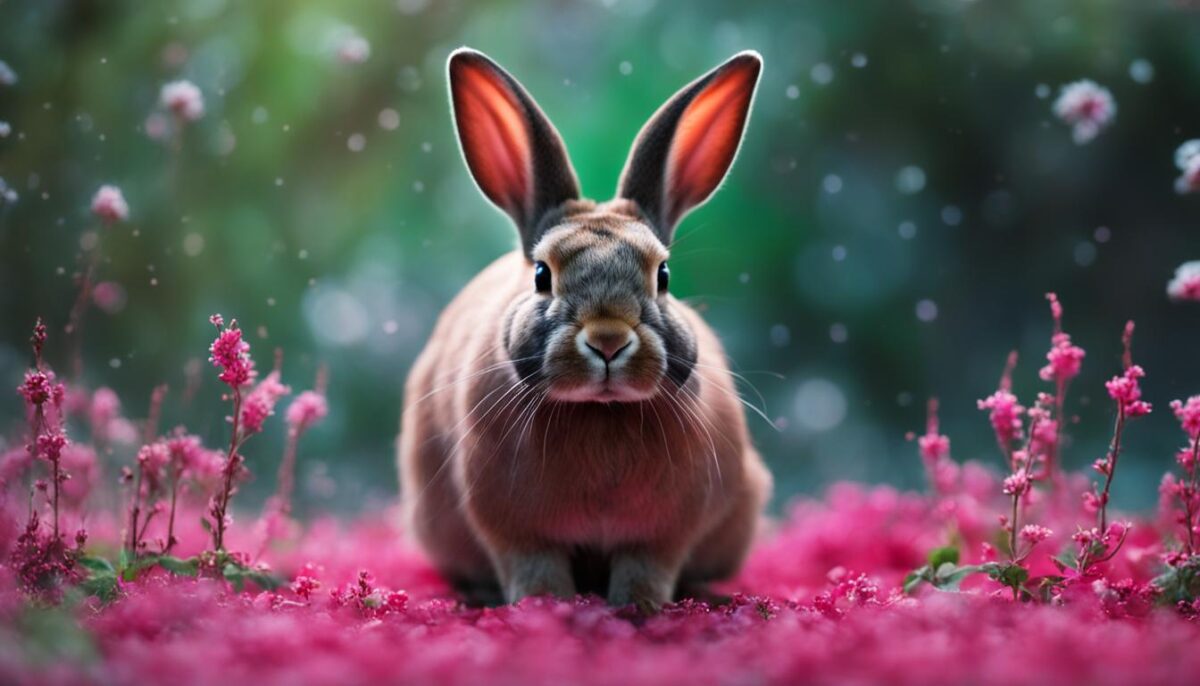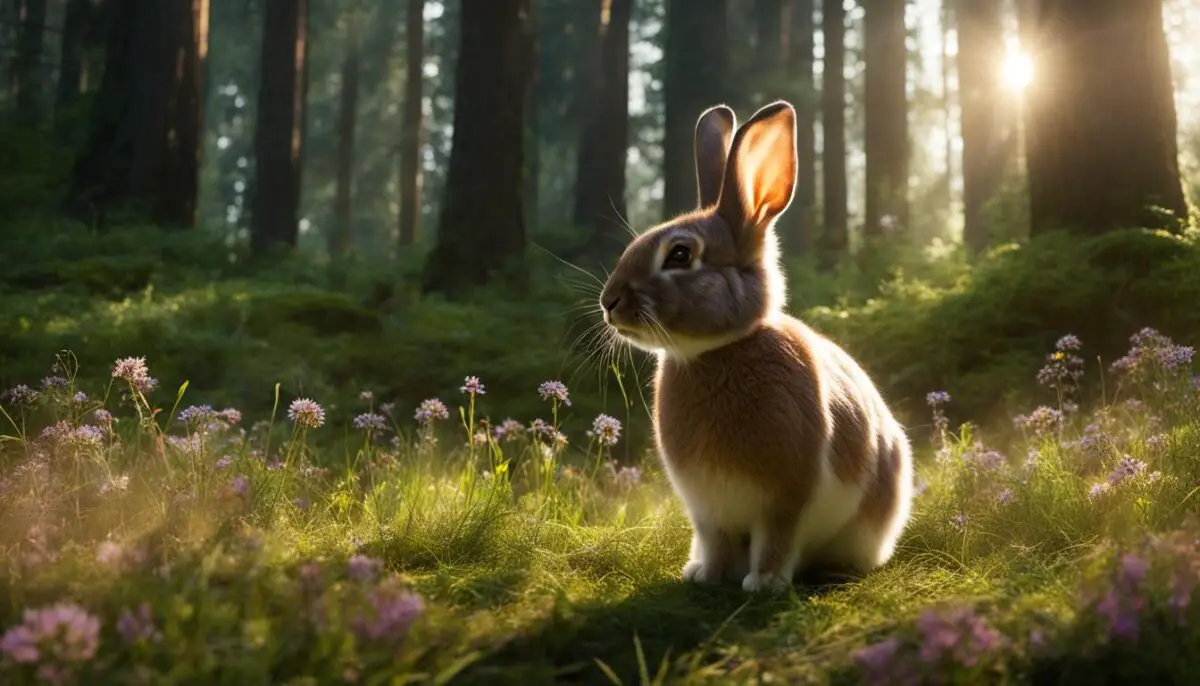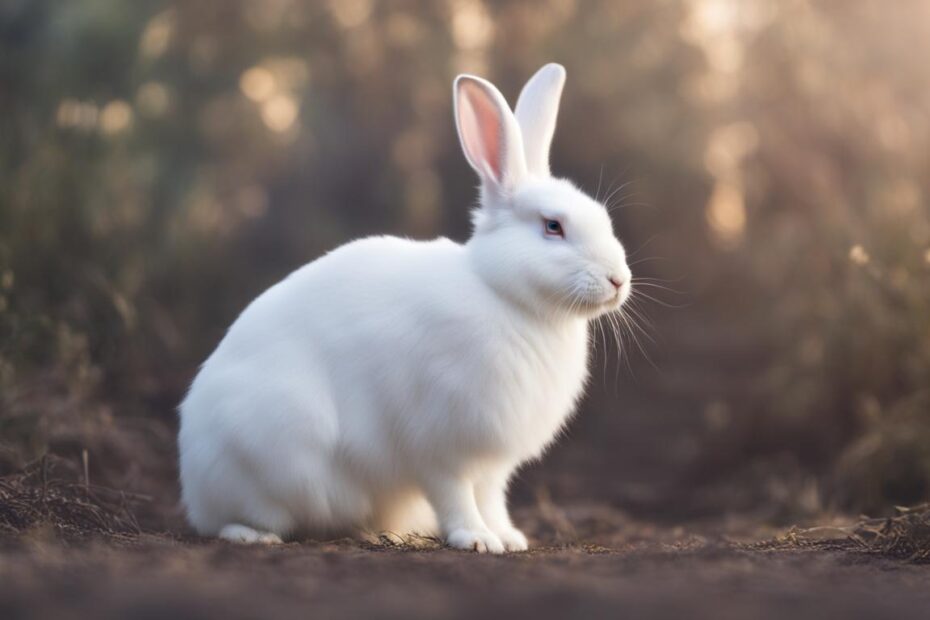Have you ever wondered if rabbits can have horns? The concept of horned rabbits, often referred to as jackalopes, has captured the imagination of many. In this article, we will delve into the myth and reality behind these horned creatures.
While there are no true horned rabbit species, there are instances where rabbits can develop horn-like growths. These growths, however, are not actual antlers but are caused by a virus called Shope’s Papilloma. These growths bear a resemblance to horns and have contributed to the myth of horned rabbits.
Join us as we explore the distinction between antlers and horns, the origins of the jackalope myth, and the role of Shope’s Papilloma Virus in the development of horn-like structures on rabbits. We will also discuss the impact on rabbit health, scientific discoveries, and the persistence of the jackalope legend.
Key Takeaways:
- True horned rabbit species do not exist, but rabbits can develop horn-like growths due to Shope’s Papilloma Virus.
- Antlers, found on species like deer, are composed of bone and shed and regrow each year, while horns are made of keratin and are permanent structures.
- The jackalope myth originated from taxidermists who created fake jackalope specimens by combining rabbit and deer antlers.
- Shope’s Papilloma Virus infects rabbits and causes the growth of horn-like structures on their bodies.
- Horn-like growths can interfere with a rabbit’s ability to eat, leading to starvation and potential fatality.
What Rabbits Have Horns
The Distinction Between Antlers and Horns
When discussing the topic of rabbits with horns, it is important to understand the distinction between antlers and horns. Antlers are found on cervid mammals such as deer and moose. They are composed of bone and have a unique characteristic of being shed and regrown each year. On the other hand, horns are permanent structures made of keratin, a tough protein found in hair and nails.
In most cases, antlers are branched and have a complex structure, while horns are typically simple and unbranched. Antlers grow from a bony base, whereas horns have a core made of spongy bone surrounded by a layer of keratin. However, it is interesting to note that rhinos are an exception, as their horns are composed entirely of keratin and do not rest on a bony base.
Understanding this distinction is crucial when examining the horn-like growths observed in rabbits affected by Shope’s Papilloma Virus. While these growths may resemble horns, they are not true antlers or horns. Instead, they are virus-induced papillomas made of keratin. This distinction helps us differentiate between the mythical concept of rabbits with horns and the scientific reality of Shope’s Papilloma Virus.
| Antlers | Horns |
|---|---|
| Composed of bone | Composed of keratin |
| Shed and regrown annually | Permanent structures |
| Often branched and complex | Usually simple and unbranched |
| Grow from a bony base | Have a core of spongy bone |
As shown in the table above, the differences between antlers and horns are quite distinct. This knowledge helps us better understand the nature of horn-like growths seen in rabbits affected by Shope’s Papilloma Virus and allows us to separate the factual from the mythical in the realm of horned rabbits.
The Origins of the Jackalope Myth
The jackalope myth has intrigued people for generations, captivating imaginations with tales of rabbits sporting majestic antlers. But where did this fascinating legend come from? To understand the origins of the jackalope myth, we must delve into the world of taxidermy chimerae and the rich folklore surrounding horned rabbits.
One of the main contributors to the popularization of the jackalope myth was the creation of fake jackalope specimens by taxidermists. These cunning craftsmen would combine the antlers of deer or antelope with rabbit mounts, creating a fantastical hybrid creature. These impressive displays sparked curiosity and perpetuated the idea that horned rabbits truly existed.what rabbits have horns
“The imaginative taxidermy creations played a significant role in shaping the jackalope legend, captivating the hearts of those who encountered them.”
However, it’s important to note that the myth of horned rabbits predates the taxidermy creations. Historical accounts and early scientific texts from various cultures mention rabbits with horn-like growths, adding a touch of truth to the folklore. In some instances, these accounts might refer to rabbits affected by Shope’s Papilloma Virus, which can induce the growth of keratinous horns on the animals’ heads.
The jackalope myth, a delightful blend of artistry and folklore, continues to capture our imaginations to this day. Its roots lie in the ingenious taxidermy creations that blended reality and fantasy, combined with ancient stories of horned rabbits. Whether you embrace the legend with a smile or seek out the truth behind horned rabbits, the allure of the jackalope remains timeless.rabbit horned species
Table: Historical Accounts of Horned Rabbits in Folklore
| Region | Story or Text |
|---|---|
| Ancient Mesopotamia | The Epic of Gilgamesh |
| Medieval Europe | Bestiaries and depictions of “horned hare” |
| Native American | Legends of horned rabbits as tricksters or magical creatures |
| Chinese | Myths featuring “Lièrén,” a horned rabbit deity |
Image:
The Role of Shope’s Papilloma Virus
Shope’s Papilloma Virus plays a significant role in the development of horn-like growths on rabbits. This virus infects rabbits and leads to the formation of keratinous tumors or virus-induced papillomas. These tumors often appear on the rabbit’s head and can resemble shaggy dreadlocks. While not true antlers or horns, these growths bear a resemblance to keratinous horns, contributing to the myth of horned rabbits. The presence of Shope’s Papilloma Virus is most common in midwestern North America, where it can result in the occurrence of horned rabbits.
“Shope’s Papilloma Virus is responsible for the development of keratinous horns on rabbits affected by the virus. These horn-like growths, although not true antlers or horns, are a result of the viral infection and can have a significant impact on the affected rabbits’ health and well-being.”
The presence of Shope’s Papilloma Virus can have implications for rabbit health. The horn-like growths caused by the virus can interfere with a rabbit’s ability to eat and can even obstruct their mouth, leading to starvation and potential fatality. While not all infected rabbits develop these horn-like growths, those that do may face significant challenges in their daily lives.rabbit antlers
| Impact of Shope’s Papilloma Virus on Rabbit Health |
|---|
| Interference with eating |
| Potential obstruction of the mouth |
| Starvation and potential fatality |
Understanding the role of Shope’s Papilloma Virus is crucial in comprehending the presence of horn-like growths on rabbits. These growths, although not true horns, are a result of the viral infection and can have a profound impact on rabbit health. The virus is a contributing factor to the development of horned rabbits, adding to the intrigue and fascination surrounding these mythical creatures.

The Impact on Rabbit Health
Rabbits affected by Shope’s Papilloma Virus and the resulting horn-like growths face significant challenges to their health. These growths can interfere with their ability to eat, leading to potential starvation and even fatality in severe cases. The presence of these tumors can obstruct the rabbit’s mouth, making it difficult or impossible for them to consume food.
Starvation becomes a real risk for rabbits with horn-like growths caused by Shope’s Papilloma Virus. Without proper nutrition, their overall health deteriorates rapidly, and they may experience weakness, lethargy, and weight loss. If left untreated, these rabbits may succumb to the effects of malnutrition and the inability to properly sustain themselves.
Shope’s Papilloma Syndrome, the condition caused by the virus, can have devastating consequences for infected rabbits. The presence of tumors or horn-like growths not only affects their eating habits but also compromises their overall well-being. It is crucial for rabbit owners and caregivers to closely monitor the health and feeding patterns of rabbits affected by this virus to ensure their welfare.rabbit horned animals
| Impact on Rabbit Health | Symptoms | Consequences |
|---|---|---|
| Tumor Interference | Obstruction of the mouth, difficulty eating, weight loss | Potential starvation, weakened immune system, reduced quality of life |
| Shope’s Papilloma Syndrome | Horn-like growths, malnutrition, lethargy | Potential fatality if left untreated, decreased overall health |
Preventive Measures
To mitigate the impact on rabbit health caused by Shope’s Papilloma Virus, early detection and intervention are crucial. Regular veterinary check-ups, especially for rabbits in regions where the virus is prevalent, can help identify any signs of horn-like growths or other symptoms associated with the virus.
Providing rabbits with a well-balanced diet, rich in essential nutrients, is vital to support their immune system and overall health. Ensuring a clean and hygienic living environment also reduces the risk of infection and the spread of the virus.
“Early detection and intervention are crucial to mitigate the impact of Shope’s Papilloma Virus on rabbit health.”
Additionally, rabbit owners should be vigilant for any changes in their pets’ eating habits, behaviors, or physical appearance. Prompt veterinary attention can help manage the symptoms and provide the best possible care for rabbits affected by the virus. No horned rabbit breeds
By prioritizing the well-being and health of rabbits, informed actions can be taken to minimize the impact of Shope’s Papilloma Virus and the associated horn-like growths on these beloved pets.
Scientific Discoveries and HPV Connection
The discovery of Shope’s Papilloma Virus and its association with horned rabbits had significant scientific implications. This groundbreaking finding challenged the prevailing belief that viruses could not cause cancer in mammals, opening up new avenues of research in the field of virology.
Shope’s Papilloma Virus, also known as the rabbit papillomavirus, is a cancer-causing virus that infects rabbits and leads to the growth of keratinous tumors or horn-like growths on their bodies. This connection between the virus and the development of papillomas in rabbits shed light on the potential role of viruses in causing cancer.
Shope’s discovery was a watershed moment in medical science. It proved that a virus could indeed be responsible for the development of tumors in mammals, challenging the long-held belief that tumors were solely the result of genetic mutations or environmental factors.
This discovery paved the way for further research into the human papillomavirus (HPV), a virus that is now known to cause various types of cancers in humans. The development of the HPV vaccine, aimed at preventing infections by the high-risk HPV strains, has been a major breakthrough in cancer prevention.are there rabbits with horns none naturally
By understanding the connection between Shope’s Papilloma Virus and the growth of horn-like structures in rabbits, researchers were able to unravel the mechanisms behind virus-induced papillomas and explore potential treatments and preventive measures.
Development of the HPV Vaccine
The discovery of Shope’s Papilloma Virus and its link to the development of horned rabbits played a crucial role in the development of the HPV vaccine. This groundbreaking research not only expanded our understanding of the papillomavirus family but also highlighted the potential for virus-induced cancers in humans.
The HPV vaccine was first introduced in 2006 and has since been proven to be highly effective in preventing HPV infections and reducing the risk of associated cancers, particularly cervical cancer. It has become an important tool in public health efforts to combat HPV-related diseases.
Through ongoing research and advancements in vaccine technology, scientists continue to improve upon the existing HPV vaccine, expanding its protection against a broader range of high-risk HPV strains. This ongoing research aims to further reduce the incidence of HPV-related cancers and improve public health outcomes.
The Persistence of the Jackalope Legend
The jackalope legend, popularized by taxidermists like Douglas Herrick, has endured over the years. The allure of the mythical creature with horn-like growths on a rabbit’s head continues to captivate people’s imaginations. Today, the jackalope remains a cherished part of American folklore, with humorous and exaggerated claims about its habits and existence.
In the world of taxidermy, Douglas Herrick is a name that stands out. Herrick and his brother Ralph are credited with creating the first jackalope mount in the 1930s. Using rabbit and deer antlers, they crafted a creature that appeared to be a horned rabbit. This inventive display sparked the imagination of many and contributed to the ongoing popularity of the jackalope. horned rabbits in nature
“The jackalope is a whimsical creation that adds a touch of magic to our folklore. It’s a testament to the creativity and humor of taxidermists like Douglas Herrick,” says wildlife enthusiast Jane Thompson.
While the existence of the jackalope may be tongue-in-cheek, the legend continues to thrive, with countless stories and sightings circulating in various parts of the country. From tales of jackalopes outwitting hunters to claims of jackalope rodeos, these whimsical tales add a touch of wonder and amusement to the folklore traditions of the United States.
| Jackalope Popularity | Taxidermy Mounts | Douglas Herrick | Tongue-in-Cheek Claims |
|---|---|---|---|
| Throughout the years, the jackalope has become an iconic symbol of American folklore, capturing the imaginations of people of all ages. | Taxidermists have played a significant role in perpetuating the jackalope legend, creating lifelike mounts that fuel the fascination surrounding the mythical creature. | Douglas Herrick, along with his brother Ralph, is credited with creating the first jackalope mount, cementing their place in taxidermy history. | Many of the claims surrounding the jackalope are tongue-in-cheek, adding to the lighthearted and humorous nature of the legend. |
Unveiling the Truth behind Horned Rabbits
While the myth of horned rabbits has captured our imaginations, the truth behind these fantastical creatures is rooted in the existence of the rabbit papillomavirus. This virus, known as Shope’s Papilloma Virus, can cause the growth of tumor-like horn structures on rabbits’ heads. Although these growths may not be as majestic as the folklore suggests, they provide fascinating insights into the interplay between viruses and tumor growth.
Unlike true horns found in other animals, the horn-like growths on rabbits affected by the papillomavirus are not made of bone or keratin, but rather result from the virus-induced papillomas. These growths can vary in size and shape, often resembling shaggy dreadlocks or bizarre protrusions. While they may not serve any practical purpose, they highlight the remarkable adaptability of the rabbit’s immune system in response to viral infections.
It is important to note that not all rabbits infected with the papillomavirus develop these horn-like growths. However, for those that do, the impact on their health can be significant. The growths can interfere with the rabbit’s ability to eat, leading to malnutrition and even starvation. Therefore, it is crucial for rabbit owners and veterinarians to monitor and address any signs of tumor interference to ensure the well-being of these unique animals.

In summary, while horned rabbits may be a myth, the existence of the rabbit papillomavirus and its ability to induce tumor-like growths provides a scientific basis for the fascination surrounding these creatures. The jackalope legend may have its origins in taxidermy creations and historical accounts of horned rabbits, but the truth lies in the fascinating interplay between viruses and tumor growth. By unraveling the mystery behind horn-like growths on rabbits, we gain a deeper understanding of the complexities of nature and the role viruses can play in shaping the animal kingdom.
Conclusion
In conclusion, the existence of true horned rabbits may be a myth, but the fascination surrounding horn-like growths on rabbits persists. Historical accounts, taxidermy creations, and the prevalence of Shope’s Papilloma Virus have all contributed to the enduring legend of the jackalope. While no rabbit species naturally possesses horns, the virus-induced growths observed in rabbits affected by Shope’s Papilloma Virus have captivated the imaginations of many.
Understanding the distinction between antlers and horns, the role of the virus, and the impact on rabbit health adds depth to the intriguing world of horned rabbits. Despite the tenuous connection between horned rabbits and the jackalope myth, both have left an indelible mark on popular culture. The tales and imagery surrounding these creatures continue to captivate and entertain.
Whether it’s the whimsical lore or the scientific fascination, the myth of horned rabbits has sparked curiosity and wonder. While the jackalope may be a creature of folklore, the horn-like growths caused by Shope’s Papilloma Virus remind us of the mysteries that nature holds. It is through unraveling these truths that we gain a deeper appreciation for the beauty and intrigue of the animal kingdom.
FAQ
Do rabbits actually have horns?
No, rabbits do not naturally have horns. However, there are instances where rabbits can develop horn-like growths.
What causes the horn-like growths on rabbits?
The growths on rabbits are caused by a virus called Shope’s Papilloma.
Are the horn-like growths on rabbits similar to antlers?
No, the growths on rabbits are not true antlers. Antlers are composed of bone and are shed and regrown annually, while the growths on rabbits are made of keratin and are permanent.
How did the jackalope myth originate?
The jackalope myth originated from taxidermists who created fake specimens by combining rabbit and deer antlers. This led to the popularization of the jackalope as a creature with horns.
Can the horn-like growths on rabbits affect their health?
Yes, the growths can interfere with a rabbit’s ability to eat and in severe cases, can lead to starvation and potential fatality.
What scientific discoveries came from studying horned rabbits?
The discovery of Shope’s Papilloma Virus and its association with horned rabbits challenged the belief that viruses could not cause cancer in mammals. It eventually led to the development of the HPV vaccine.
Is the jackalope legend still popular today?
Yes, the jackalope remains a cherished part of American folklore with humorous and exaggerated claims about its habits and existence.
Do horned rabbits actually exist?
While rabbits with true horns do not exist, the myth of horned rabbits persists due to historical accounts and the prevalence of Shope’s Papilloma Virus.


